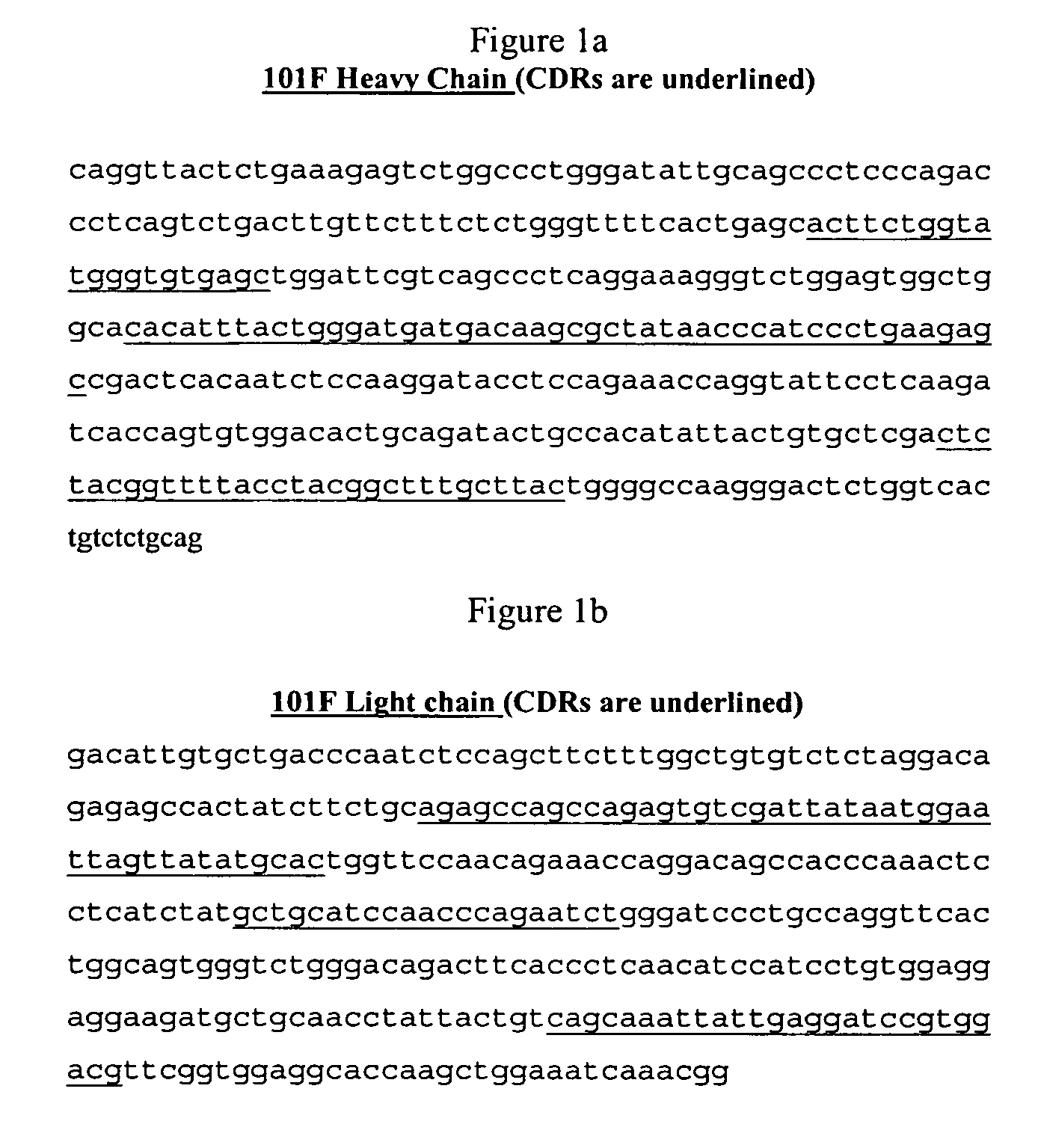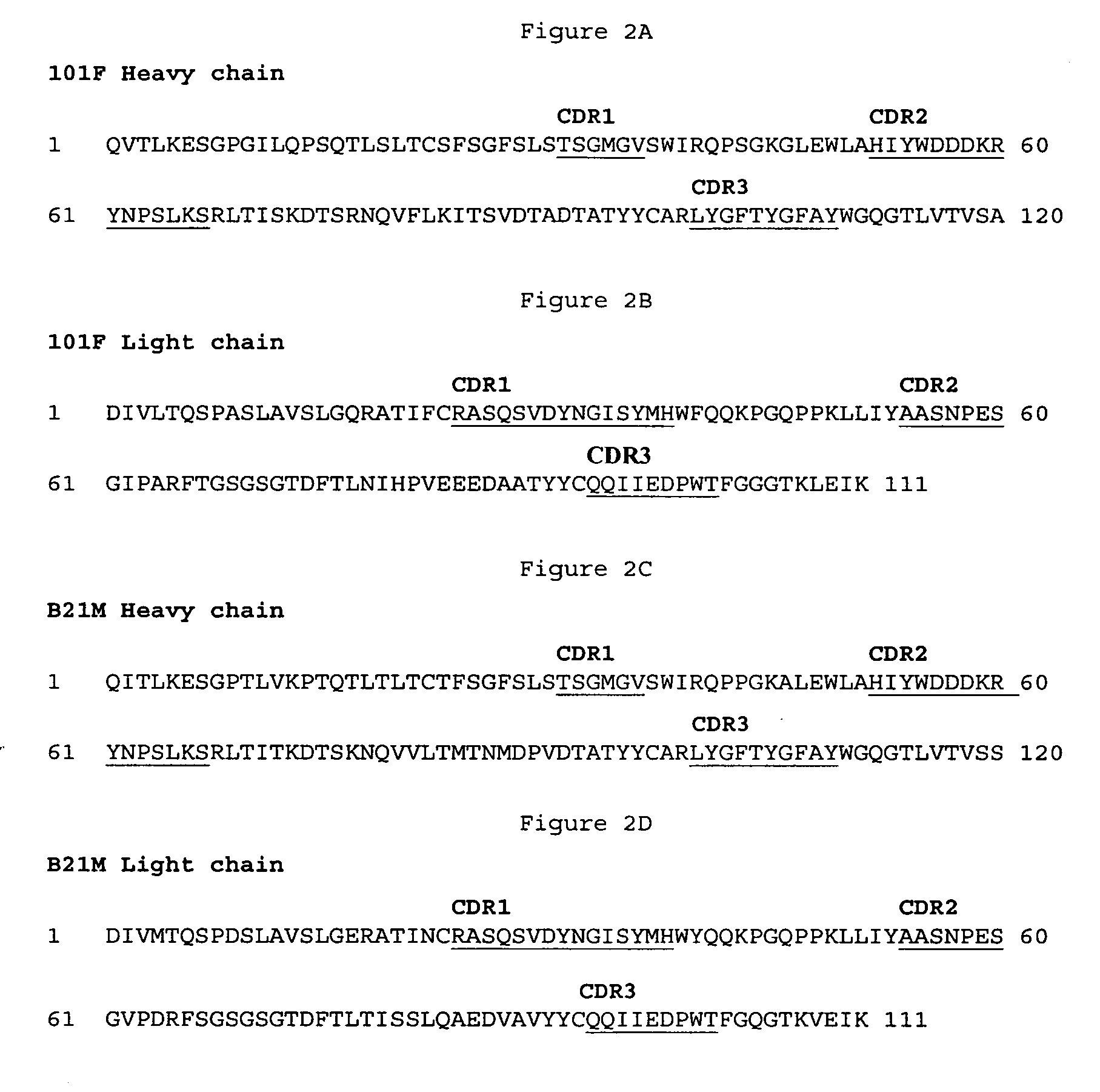Anti-respiratory syncytial virus antibodies, antigens and uses thereof
a technology of respiratory syncytial virus and antibody, which is applied in the field of neutralizing antibodies to respiratory syncytial virus (rsv), can solve the problems of ineffective therapeutic antiviral agents that exist, the hospitalization rate of at-risk infants with synagis® only reduces overall hospitalization rates by 55%, and the hospitalization rate of at-risk infants significantly less in those with bpd
- Summary
- Abstract
- Description
- Claims
- Application Information
AI Technical Summary
Problems solved by technology
Method used
Image
Examples
example 1
Generation and Selection of an Anti-RSV mAb 101F
[0071] Anti-RSV mAbs were generated in normal BALB / c mice using standard hybridoma technology (Kohler et al., Nature 256: 495-497 (1975)). Mice were immunized essentially as previously described (Garcia-Barreno et al., J. Virol. 63:925-932, 1989) using a combinantion of purified virus (Long strain) and purified F protein (derived from RSV Long strain).
[0072] Three days prior to B cell fusion, female BALB / c mice were given an intravenous injection of the immunogen in PBS). Spleens from immunized mice were harvested and B cell fusion with Sp2 / 0 myeloma cells was carried out using standard methods of Kohler et al., supra. Fused cells were selected using medium containing hypoxanthine-aminopterin-thymidine and wells were screened for the presence of anti-RSV F antibodies by enzyme-linked immunosorbent assay (ELISA) using either purified virus or purified F protein as the antigen. Positive wells are expanded and cloned by limiting dilutio...
example 2
Cloning and Sequencing of 101F Heavy and Light Chain Variable Region Genes
[0074] Total RNA from a hybridoma cell line expressing murine 101F IgG2a kappa was purified for cDNA generation using a GeneRacer Kit for 5′ RACE (InVitrogen, Carlsbad, Calif.). Oligo dT supplied with the kit primed the cDNA synthesis portion of the protocol. To obtain the heavy chain variable region gene, the cDNA was used as template in a touchdown PCR reaction according to the manufacturer's instructions. Equal amounts of GeneRacer 5′ primer (5′-CGACTGGAGCACGAGGACACTGA-3′) (SEQ ID NO: 19) and rat IgG2a 3′ primer 642 (5′-CTGTCCCGAGGTCTCAAGG-3′) (SEQ ID NO: 20) generated the expected size band of 660 bp after the reaction. The same template and reaction conditions were used to obtain the light chain variable region. Equal amounts of the GeneRacer 5′ primer (SEQ ID NO: 19) and rat kappa 3′ primer 645 (5′-GAACTGTGACTACAGAGACC-3′) (SEQ ID NO: 21) generated the expected size band of 700 base pairs. Both heavy an...
example 3
Cloning of anti-RSV mAb 101F and Chimeric 101F Transient Constructs
[0075] The heavy chain variable region cDNA was used as a template in a polymerase chain reaction (PCR) using oligos 101HC5′ and 101HC3′ (sequences shown below).
(SEQ ID NO: 22)101HC5′: 5′-TTCGTACGGCCACCATGGACAGGCTTACTTCCT-3′(SEQ ID NO: 23)101HC3′: 5′-TTCGAAACTTACCTGCAGAGACAGTGACCA-3′
[0076] These primers added a Kozak consensus sequence (underlined) to the translational start site (boldface) and appropriate restriction sites, BsiWI and BstBI (in italics). This amplified fragment was cloned into the BsiWI and BstBI sites of the murine genomic IgG2a expression plasmid p2370 containing the HCMV promoter and the SV40 polyadenylation site to generate the transient expression plasmid p2504 encoding the murine 101F IgG2a heavy chain. The light chain variable region cDNA was used as template and amplified with oligos LC101LIC5′ and LC101LIC3′ (sequences shown below), which add a Kozak consensus sequence (underlined) to the...
PUM
| Property | Measurement | Unit |
|---|---|---|
| pH | aaaaa | aaaaa |
| concentration | aaaaa | aaaaa |
| pH | aaaaa | aaaaa |
Abstract
Description
Claims
Application Information
 Login to View More
Login to View More - R&D
- Intellectual Property
- Life Sciences
- Materials
- Tech Scout
- Unparalleled Data Quality
- Higher Quality Content
- 60% Fewer Hallucinations
Browse by: Latest US Patents, China's latest patents, Technical Efficacy Thesaurus, Application Domain, Technology Topic, Popular Technical Reports.
© 2025 PatSnap. All rights reserved.Legal|Privacy policy|Modern Slavery Act Transparency Statement|Sitemap|About US| Contact US: help@patsnap.com



